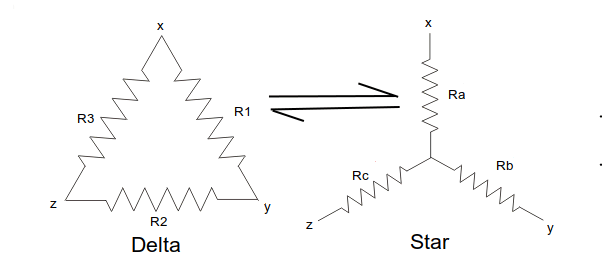Star-Delta Transformation
The star-delta transformation, also known as the delta-star transformation, is a technique used in electrical circuit analysis to simplify complex networks, particularly those involving resistors or impedances. This transformation involves converting either a star configuration to a delta configuration or vice versa.
Delta To Star Conversion

Consider a delta system that has three corner points that are , and as shown in the figure. Electrical resistance of the branch between points and , and and and are , and respectively.
The resistance between the points and will be,
Now, one star system is connected to these points , , and as shown in the figure. Three arms , and of the star system are connected with , and respectively. Now if we measure the resistance value between points and , we will get,
Since the two systems are identical, resistance measured between terminals and in both systems must be equal.
Similarly, resistance between points and being equal in the two systems,
And resistance between points and being equal in the two systems,
Adding equations (1), (2) and (3) we get,
Subtracting equations (1), (2) and (3) from equation (4) we get,
The relation of delta - star transformation can be expressed as follows. The equivalent star resistance connected to a given terminal, is equal to the product of the two delta resistances connected to the same terminal divided by the sum of the delta connected resistances. If the delta connected system has same resistance at its three sides then equivalent star resistance will be,
Star To Delta Conversion
For star - delta transformation we just multiply equations (5), (6) and (6), (7) and (7), (5) that is by doing (5) x (6) + (6) x (7) + (7) x (5) we get,
Now dividing equation (8) by equations (5), (6) and equations (7) separately we get,
For the reverse transformation, the star-delta transformation, the equivalent delta resistance connected between any two terminals in the delta configuration would be three times the equivalent star resistance connected to those same terminals. Therefore:
Click here to open youtube playlist containing numericals on Star-Delta Transformation.